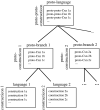Constructing a protolanguage: reconstructing prehistoric languages in a usage-based construction grammar framework
- PMID: 33745320
- PMCID: PMC8059648
- DOI: 10.1098/rstb.2020.0200
Constructing a protolanguage: reconstructing prehistoric languages in a usage-based construction grammar framework
Abstract
Construction grammar is an approach to language that posits that units and structures in language can be exhaustively described as pairings between form and meaning. These pairings are called constructions and can have different degrees of abstraction, i.e. they span the entire range from very concrete (armadillo, avocado) to very abstract constructions such as the ditransitive construction (I gave her a book). This approach has been applied to a wide variety of different areas of research in linguistics, such as how new constructions emerge and change historically. It has also been applied to investigate the evolutionary emergence of modern fully fledged language, i.e. the question of how systems of constructions can arise out of prelinguistic communication. In this paper, we review the contribution of usage-based construction grammar approaches to language change and language evolution to the questions of (i) the structure and nature of prehistoric languages and (ii) how constructions in prehistoric languages emerged out of non-linguistic or protolinguistic communication. In particular, we discuss the possibilities of using constructions as the main unit of analysis both in reconstructing predecessors of existing languages (protolanguages) and in formulating theories of how a potential predecessor of human language in general (protolanguage) must have looked like. This article is part of the theme issue 'Reconstructing prehistoric languages'.
Keywords: construction grammar; linguistic reconstruction; protolanguage; syntactic reconstruction; usage-based linguistics.
Figures
Similar articles
-
Reconstructing prehistoric languages.Philos Trans R Soc Lond B Biol Sci. 2021 May 10;376(1824):20200187. doi: 10.1098/rstb.2020.0187. Epub 2021 Mar 22. Philos Trans R Soc Lond B Biol Sci. 2021. PMID: 33745317 Free PMC article.
-
Comparing prehistoric constructed languages: world-building and its role in understanding prehistoric languages.Philos Trans R Soc Lond B Biol Sci. 2021 May 10;376(1824):20200201. doi: 10.1098/rstb.2020.0201. Epub 2021 Mar 22. Philos Trans R Soc Lond B Biol Sci. 2021. PMID: 33745307 Free PMC article.
-
At the boundaries of syntactic prehistory.Philos Trans R Soc Lond B Biol Sci. 2021 May 10;376(1824):20200197. doi: 10.1098/rstb.2020.0197. Epub 2021 Mar 22. Philos Trans R Soc Lond B Biol Sci. 2021. PMID: 33745316 Free PMC article.
-
The evolutionary dynamics of language.Biosystems. 2018 Feb;164:128-137. doi: 10.1016/j.biosystems.2017.11.003. Epub 2017 Nov 7. Biosystems. 2018. PMID: 29122586 Review.
-
Human language is a culturally evolving system.Psychon Bull Rev. 2017 Feb;24(1):190-193. doi: 10.3758/s13423-016-1086-6. Psychon Bull Rev. 2017. PMID: 27439501 Review.
Cited by
-
Reconstructing prehistoric languages.Philos Trans R Soc Lond B Biol Sci. 2021 May 10;376(1824):20200187. doi: 10.1098/rstb.2020.0187. Epub 2021 Mar 22. Philos Trans R Soc Lond B Biol Sci. 2021. PMID: 33745317 Free PMC article.
References
-
- Tallerman M. 2012. Protolanguage. In The Oxford handbook of language evolution (eds Tallerman M, Gibson KR), pp. 479-491. Oxford, UK: Oxford University Press.
-
- Crowley T, Bowern C. 2010. An introduction to historical linguistics, 4th edn. Oxford, UK: Oxford University Press.
-
- Heine B, Kuteva T. 2007. The genesis of grammar: a reconstruction. Oxford, UK: Oxford University Press.
-
- Bybee J. 2010. Language, usage and cognition. Cambridge, UK: Cambridge University Press.
-
- Arbib MA. 2012. How the brain got language: the mirror systems hypothesis. Oxford, UK: Oxford University Press.
Publication types
MeSH terms
LinkOut - more resources
Full Text Sources
Other Literature Sources


